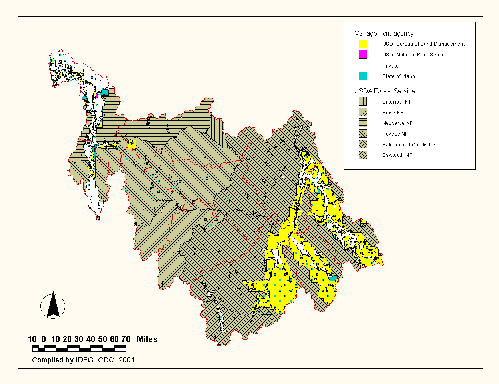
Appendix E. Major Land Uses and Population Demographics
Click on image to view full-sized version.
Figure E-1. Salmon subbasin landownership patterns.
Figure E-2. Salmon River subbasin general landuse patterns. Land management status (see Table s3ownerxmac.doc for detailed descriptions of land management classes) is shown in relation to land ownership status and mining claims. The inset displays the distribution of range allotments within the subbasin (adapted from citation).
Table E-1. Land management classes for areas under different ownership or management, Salmon Subbasin, Idaho. Class narrative descriptions follow below.
|
Managing agency or owner |
Management class |
|||||||
|
na |
1 |
2 |
3 |
4 |
5 |
6 |
8 |
|
|
USDI Bureau of Land Management |
5.3 |
14.1 |
2.5 |
0.6 |
3.6 |
11.7 |
62.2 |
0.0 |
|
USDA Forest Service |
0.1 |
40.7 |
1.1 |
25.7 |
0.3 |
27.1 |
3.9 |
1.0 |
|
Private |
84.9 |
0.9 |
0.7 |
4.5 |
0.5 |
4.1 |
4.1 |
0.4 |
|
State of Idaho |
75.1 |
7.4 |
0.1 |
3.4 |
0.8 |
1.9 |
10.9 |
0.4 |
1. Natural, Unmodified Environments - Ecological processes such as fire, insects, and disease are essentially allowed to operate relatively free from influence from humans. Diversity resulting from natural succession and disturbance predominates and non-native vegetation is rare. Users must be self-reliant and expect low levels of contacts with others. Few, if any structural improvement exists and travel is almost always non-motorized. Typical types of areas: Designated Wilderness, Wilderness Study Areas, rivers designated/suitable/eligible for Wild River classification, most Research Natural Areas and backcountry lands.
2. Special Natural Areas-These areas provide for conservation of representative or particular rare and narrowly distributed ecological settings or components. This helps insure conservation of ecosystems or components that may provide important functions insuring overall sustainability of larger landscapes. The influences of humans on the ecosystem are sometimes evident. Types of human uses varies somewhat but generally is non-intensive. Travel is generally non-motorized. Some of these areas help provide an important role under an adaptive management philosophy by providing a "natural" reference for areas heavily managed for particular objectives. These areas are often formally designated and include some Research Natural Areas, designated, suitable or eligible Scenic Rivers outside of Wilderness, most (non-ONA) Areas of Critical Environmental Concern (ACECs), old growth reserves, and other special areas are typically included.
3. Essentially Unmodified Forested and Grassland Ecosystems-Although the areas are characterized by predominantly natural appearing landscape, an array of management tools can be used to restore or maintain relatively natural patterns of ecological processes. This will result in some evidence of man
=s activities. Ecological values are in balance with human occupancy with consideration given for both. Resource management activities may occur but natural ecological processes and resulting patterns will normally predominate. Users may expect to experience some challenge and risk. Restrictions on motorized travel can vary from area to area and season to season. This category would include all unsuitable forests and woodlands with no planned harvest, all special status species habitat areas and all designed and occupied wild horse/burro areas.4. Natural Appearing, but Modified for Human Use and Occupancy-Ecological values are managed to provide human recreational use, but are maintained well within levels necessary to maintain overall ecological systems. Resource use for other values is not emphasized and has little impact on ecological structure, function, or composition. Human use is recreation oriented. Sights and sounds of humans onsite can be expected and even desired. Motorized transportation is common. This category would include all designated/suitable/eligible recreational rivers, all non-linear recreation sites and areas, all other ONA/ACEC and environmental education sites.
5. Modified Forest Ecosystems-The areas are primarily forested ecosystems and are managed to meet a variety of ecological and human needs. Ecological conditions will be maintained with an emphasis on selected structures and compositions within the range of natural variability. These lands often display high levels of forest management investment, use and/or activity, density of facilities; and evidence of vegetative manipulation activities. Forest users expect to see other humans and evidence of man
=s activities. Facilities in support of various resource use are common. Motorized transportation is common.6. Modified Grassland-The areas are primarily grasslands, and many woodland ecosystems, and are managed to meet a variety of ecological and human needs. Ecological condition objectives are likely to have an emphasis on selected structures and compositions within the range of natural variability. These lands often display high levels of investment, use and/or activity, density of facilities, and evidence of vegetative manipulation activities. A wide variety of structure and composition is present. Users expect to see other humans and evidence of man's activities. Facilities in support of various resource uses are common. Motorized transportation is common.
7. Areas Modified by Human Occupation and Activities-Public lands are intermingled with private lands to the point that without the support and cooperation of the private sector, BLM/Forest Service cannot effectively manage for ecological values. Human activities have altered the natural appearances in most of these areas, both on private and public lands. Sights and sounds of humans are predominant. Private landuse is often intensive agriculture, industrial or residential or zoned for residential (40 acres or less/lot).Resource use may not be planned on a sustainable basis but may occur in concert with surrounding private land values. Motorized transportation is common.
8. Modified Non-Sustainable Areas-Ecological conditions (including processes) are likely to be or have been permanently altered by human activities beyond the level needed to maintain natural appearing landscapes and ecological processes. The areas are generally small but could involve the core area of large mining districts. Ecological values are protected where they affect the heath and welfare of human occupancy. Areas such as mines and other concentrated uses are included. Human activities are generally commercial in nature and directly or indirectly provide jobs and income. Motorized transportation is common.